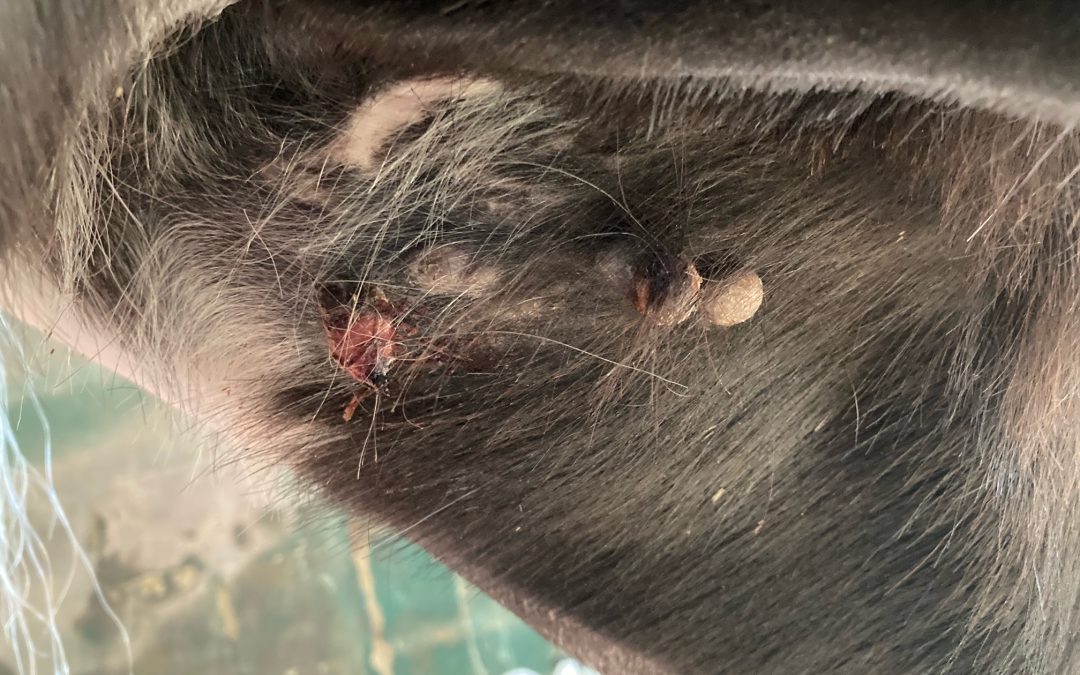Sarcoids and melanomas are the most common skin tumors in horses. These growths can appear at any age, and if a horse develops one, there may be others hidden beneath the skin. While often considered benign equine tumors, they can grow significantly and spread locally, sometimes impacting the horse’s comfort and well-being.
Sarcoids in Horses:
Sarcoids are the most common equine skin tumor, affecting all breeds and ages. Research suggests they are linked to bovine papillomavirus (BPV), though not every horse exposed to the virus will develop them. Certain horses may have a genetic predisposition to sarcoids.
Types of Equine Sarcoids:
There are four main types of sarcoids in horses:
- Occult Sarcoids – These can be subtle, appearing as hair loss, a coat color change, or thickened, grainy skin.
- Verrucose Sarcoids – Often gray, scaly, or wart-like, these slow-growing sarcoids may resemble ringworm or scar tissue.
- Nodular Sarcoids – These are the classic firm, round lumps under the skin that many horse owners recognize.
- Fibroblastic Sarcoids – These aggressive, ulcerating, and bleeding tumors can attract flies in warmer months, leading to secondary infections.
Some horses may develop mixed sarcoids, where multiple types merge into a larger plaque. In rare cases, malignant sarcoids can spread through lymphatic vessels, creating a network of tumors.
Common areas where sarcoids appear:
- Around the eyes
- Between the front legs
- Midline of the abdomen
- Sheath region
- Inner thigh’s
These are usually areas where the hair is missing, often seen as the winter coat sheds in the spring.
Sarcoid Treatment in Horses:
Treatment depends on the sarcoid type, size, and location. The earlier they are addressed, the better the prognosis. Our veterinary team consults with Professor Derek Knottenbelt, an equine medicine specialist, for expert advice on sarcoid management.
Common sarcoid treatment options include:
✅ Topical chemotherapy
✅ Cryotherapy (freezing the tumor)
✅ Surgical or laser removal
✅ Immunotherapy to stimulate the horse’s immune system
Melanomas in Horses:
Melanomas in horses are almost exclusively seen in grey horses and appear as black, hairless lumps. These tumors commonly develop:
📍 Under the tail
📍 In and around the sheath
📍 Around the eyes
📍 Near the throat, or around the jaw and salivary glands.
Are Equine Melanomas Dangerous?
While some melanomas remain small for years, others can grow large enough to cause problems. If untreated, melanomas may:
❌ Obstruct the anus
❌ Grow within salivary glands or lymph nodes
❌ Develop internally, potentially leading to obstructive colic
Melanoma Treatment for Horses
Over 80% of grey horses will develop melanomas during their lifetime. Early detection and removal, while tumors are still small, can prevent complications. Treatment may involve:
✔ Surgical removal
✔ Laser therapy
✔ Experimental melanoma vaccines
Though melanomas can also occur in non-grey horses, they are much rarer but tend to be more aggressive.
Concerned About a Lump on Your Horse?
If you’ve noticed a lump, bump, or unusual skin change, early intervention is key. Our experienced equine vets are here to help! Call us at 📞 01782 898102 for advice and treatment options

